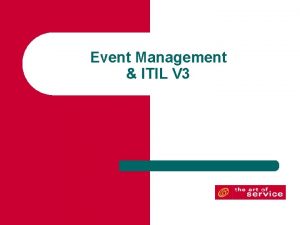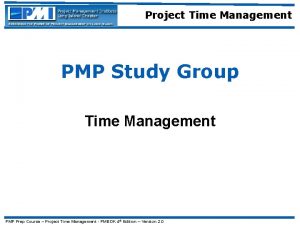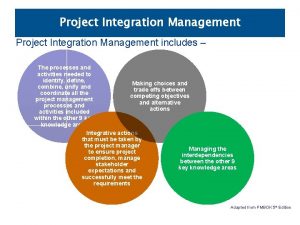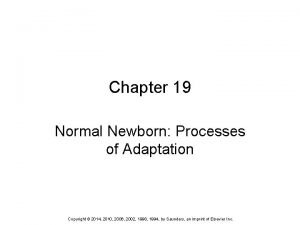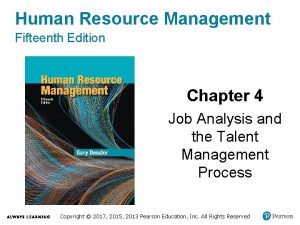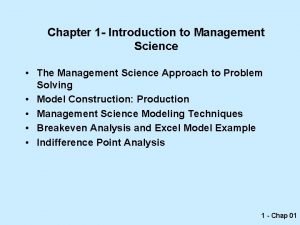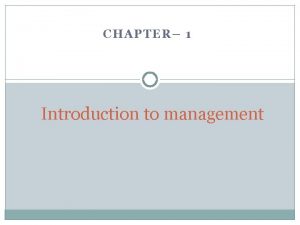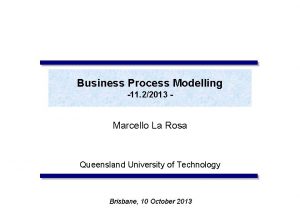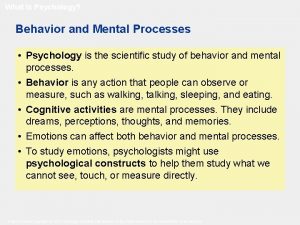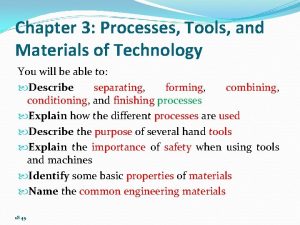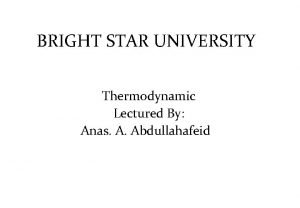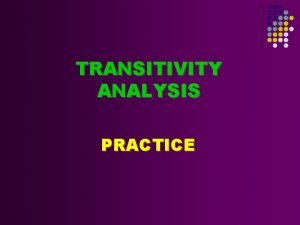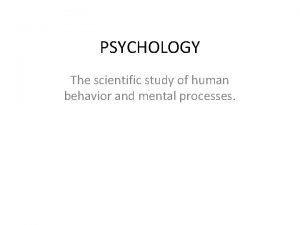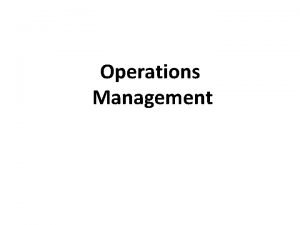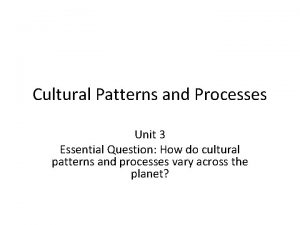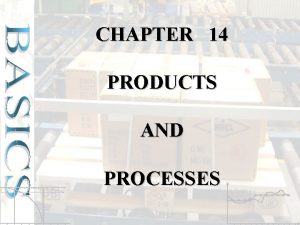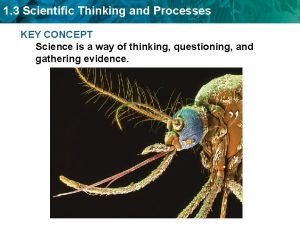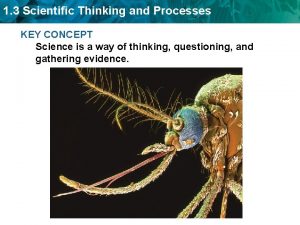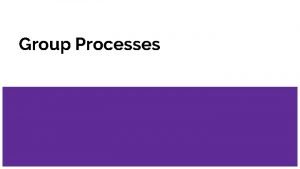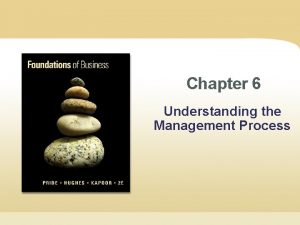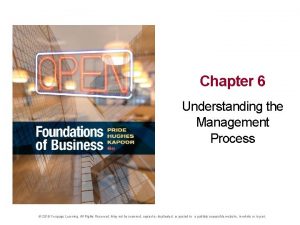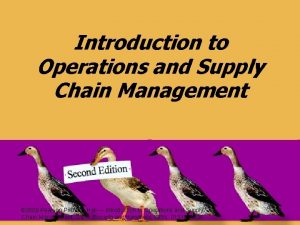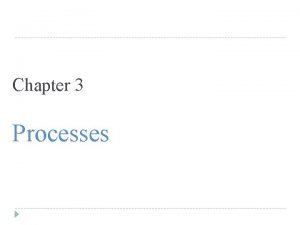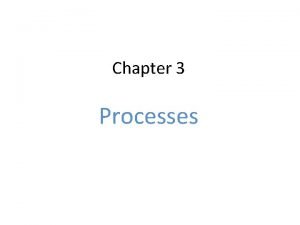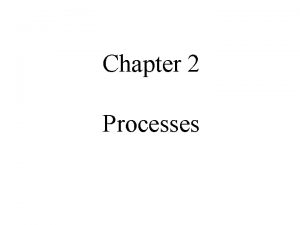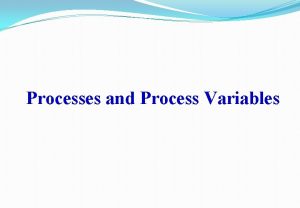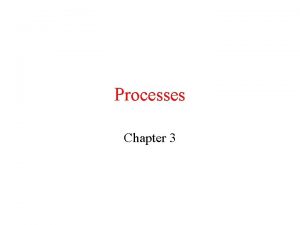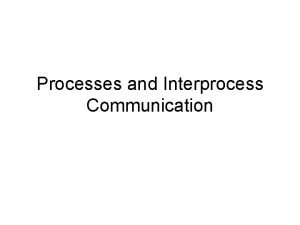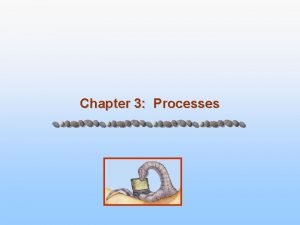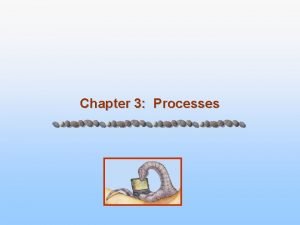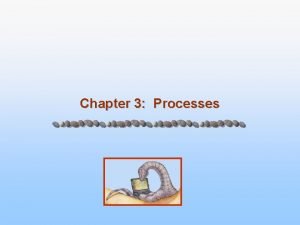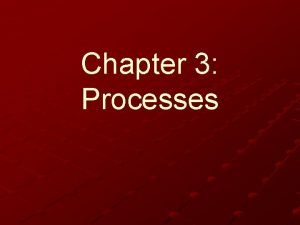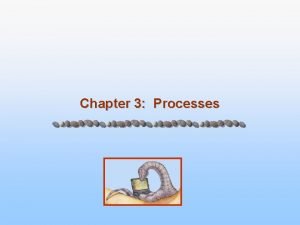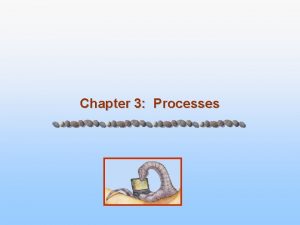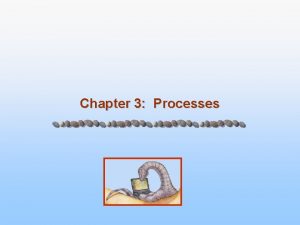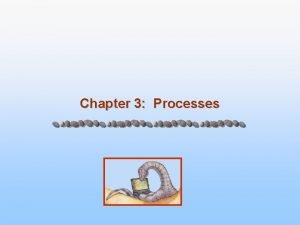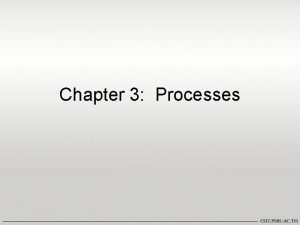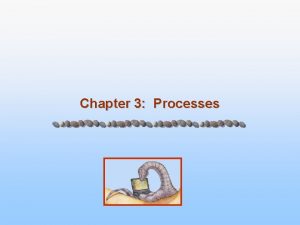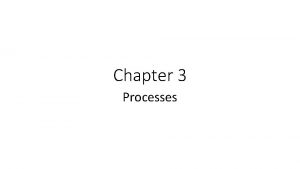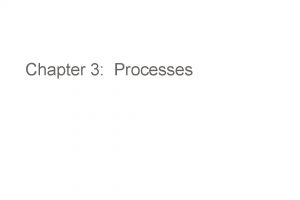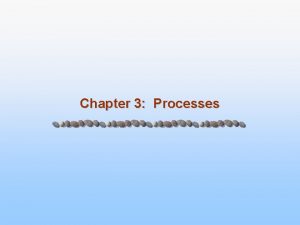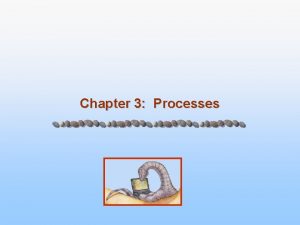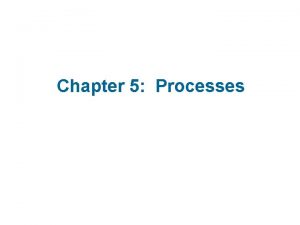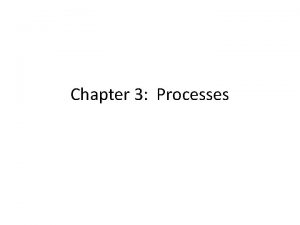Chapter 2 Processes And Process Management Introduction Process

































































- Slides: 65

Chapter 2 : Processes And Process Management

Introduction Process Concept Process Scheduling Operations on Processes Interprocess Communication Examples of IPC Systems Communication in Client-Server Systems

Objectives To introduce the notion of a process -- a program in execution, which forms the basis of all computation To describe the various features of processes, including scheduling, creation and termination, and communication To describe communication in client-server systems

Process Concept An operating system executes a variety of programs: Batch system – jobs Time-shared systems – user programs or tasks Textbook uses the terms job and process almost interchangeably Process – a program in execution; process execution must progress in sequential fashion A process includes: program counter stack data section

Process in Memory

Process State As a process executes, it changes state new: The process is being created running: Instructions are being executed waiting: The process is waiting for some event to occur ready: The process is waiting to be assigned to a processor terminated: The process has finished execution

Diagram of Process State

Implementation of Processes Control Block (PCB) Information associated with each process Process state Program counter CPU registers CPU scheduling information Memory-management information Accounting information I/O status information

Process Control Block (PCB)

CPU Switch From Process to Process

The Thread Model Lightweight processes Per process items Address space Global variables Open files Child processes Pending alarms Signals and signal handlers Accounting information Per thread items Program counter Registers Stack State

Why Threads? Quasi Parallelism They are easier to create and destroy than processes

Process Scheduling Queues Job queue – set of all processes in the system Ready queue – set of all processes residing in main memory, ready and waiting to execute Device queues – set of processes waiting for an I/O device Processes migrate among the various queues

Ready Queue And Various I/O Device Queues

Representation of Process Scheduling

Schedulers Selects which processes should be brought into the ready queue Selects which process should be executed next and allocates CPU

Addition of Medium Term Scheduling

Schedulers (Cont) Short-term scheduler is invoked very frequently (milliseconds) (must be fast) Long-term scheduler is invoked very infrequently (seconds, minutes) (may be slow) The long-term scheduler controls the degree of multiprogramming Processes can be described as either: I/O-bound process – spends more time doing I/O than computations, many short CPU bursts CPU-bound process – spends more time doing computations; few very long CPU bursts

Context Switch When CPU switches to another process, the system must save the state of the old process and load the saved state for the new process via a context switch Context of a process represented in the PCB Context-switch time is overhead; the system does no useful work while switching Time dependent on hardware support

Process Creation Process creation can be triggered in either of System initialization. Execution of a process creation system call by a running process. A user request to create a new process. Initiation of a batch job. Parent process create children processes, which, in turn create other processes, forming a tree of processes Generally, process identified and managed via a process identifier (pid) Resource sharing Parent and children share all resources Children share subset of parent’s resources Parent and child share no resources Execution Parent and children execute concurrently Parent waits until children terminate

Process Creation (Cont) Address space Child duplicate of parent Child has a program loaded into it UNIX examples fork system call creates new process exec system call used after a fork to replace the process’ memory space with a new program

Process Creation

C Program Forking Separate Process int main() { pid_t pid; /* fork another process */ pid = fork(); if (pid < 0) { /* error occurred */ fprintf(stderr, "Fork Failed"); exit(-1); } else if (pid == 0) { /* child process */ execlp("/bin/ls", "ls", NULL); } else { /* parent process */ /* parent will wait for the child to complete */ wait (NULL); printf ("Child Complete"); exit(0); } }

A tree of processes on a typical Solaris

Process Termination Normal exit (voluntary). Error exit (voluntary). Fatal error (involuntary). Killed by another process (involuntary) Process executes last statement and asks the operating system to delete it (exit) Output data from child to parent (via wait) Process’ resources are de-allocated by operating system Parent may terminate execution of children processes (abort) Child has exceeded allocated resources Task assigned to child is no longer required If parent is exiting Some operating system do not allow child to continue if its parent terminates All children terminated - cascading termination

Interprocess Communication Processes within a system may be independent or cooperating Cooperating process can affect or be affected by other processes, including sharing data Reasons for cooperating processes: Information sharing Computation speedup Modularity Convenience Cooperating processes need interprocess communication (IPC) Two models of IPC Shared memory Message passing

Communications Models

Communications Model… Race Conditions , Critical sections, & Mutual Exclusion

Communication Models… Although mutual exclusion avoids race conditions, it is not sufficient for having parallel processes cooperate correctly and efficiently using shared data. There needs to be four conditions to hold to have a good solution: 1. No two processes may be simultaneously inside their critical regions 2. No assumptions may be made about speeds or the number of CPUs 3. No process running outside its critical region may block other processes 4. No process should have to wait forever to enter its critical region

Communication Models… Techniques for achieving mutual exclusion Mutual Exclusion with Busy Waiting Disabling Interrupts Lock Variables Strict Alternation Peterson’s Algorithm The TSL Instruction

Communication Models… Assignment- Group 1 - Prepare a comparative analysis of the busywaiting algorithms described in the previous slide.

Communication Models… Mutual Exclusion without Busy Waiting - Problems of Busy-Waiting - Wastes CPU time - Priority inversion problem Blocking instead of wasting CPU time- Without Busy Waiting

Cooperating Processes Independent process cannot affect or be affected by the execution of another process Cooperating process can affect or be affected by the execution of another process Advantages of process cooperation Information sharing Computation speed-up Modularity Convenience

Producer-Consumer Problem Paradigm for cooperating processes, producer process produces information that is consumed by a consumer process unbounded-buffer places no practical limit on the size of the buffer bounded-buffer assumes that there is a fixed buffer size

Bounded-Buffer – Producer while (true) { /* Produce an item */ while (((in = (in + 1) % BUFFER SIZE count) == out) ; /* do nothing -- no free buffers */ buffer[in] = item; in = (in + 1) % BUFFER SIZE; }

Bounded Buffer – Consumer while (true) { while (in == out) ; // do nothing -- nothing to consume // remove an item from the buffer item = buffer[out]; out = (out + 1) % BUFFER SIZE; return item; }

Producer-Consumer Problem… Sleep and Wakeup – uses two system calls called sleep and wakeup. Sleep causes the caller to block, that is, be suspended until another process wakes it up. The wakeup call awakens a process blocked by sleep.

Producer-Consumer Problem… #define N 100 /* number of slots in the buffer */ int count = 0; /* number of items in the buffer */ void producer (void) { int item; while (TRUE) { /* repeat forever */ item = produce_item(); /* generate next item */ if (count == N) sleep(); /* if buffer is full, go to sleep */ insert_item(item); /* put item in buffer */ count = count + 1; /* increment count of items in buffer */ if (count == 1) wakeup(consumer); /* was buffer empty? */ } } void consumer(void) { int item; while (TRUE) { /* repeat forever */ if (count == 0) sleep(); /* if buffer is empty, got to sleep */ item = remove_item(); /* take item out of buffer */ count = count − 1; /* decrement count of items in buffer */ if (count == N − 1) wakeup(producer); /* was buffer full? */ consume_item(item); /* print item */ } }

Semaphores Uses an integer variable (semaphore) to count the number of wakeups saved for future use. A semaphore could have the value 0, indicating that no wakeups were saved, or some positive value if one or more wakeups were pending. Two operations, down and up (generalizations of sleep and wakeup, respectively) would be performed on this variable. The down operation on a semaphore checks to see if the value is greater than 0. If so, it decrements the value (i. e. , uses up one stored wakeup) and just continues. If the value is 0, the process is put to sleep without completing the down for the moment. Checking the value, changing it and possibly going to sleep, is all done as a

Semaphores… This atomicity is absolutely essential to solving synchronization problems and avoiding race conditions. The up operation increments the value of the semaphore addressed. If one or more processes were sleeping on that semaphore, unable to complete an earlier down operation, one of them is chosen by the system (e. g. , at random) and is allowed to complete its down.

Other Possible IPC Mechanisms Classical IPC Problems The Dining Philosophers Problem The Readers and Writers Problem The Sleeping Barber Problem Assignment Group II Semaphore Monitors Message Passing

Interprocess Communication – Message Passing Mechanism for processes to communicate and to synchronize their actions Message system – processes communicate with each other without resorting to shared variables IPC facility provides two operations: send(message) – message size fixed or variable receive(message) If P and Q wish to communicate, they need to: establish a communication link between them exchange messages via send/receive Implementation of communication link

Communications in Client-Server Systems Sockets Remote Procedure Calls Remote Method Invocation (Java)

SCHEDULING Why Scheduling? Multiprogramming The part of the operating system that makes the choice is called the scheduler and the algorithm it uses is called the scheduling algorithm. Process Behavior: Compute-Bound I/O-Bound When to Schedule? When a new process is created When a process exits. When a process blocks on I/O, on a semaphore, or for some other reason When an I/O interrupt occurs

SCHEDULING… Scheduling algorithms can be divided into two categories: Non-preemptive- run through completion Suited for batch systems Preemptive- the scheduler picks a process and lets it run for a maximum of some fixed time. Suited for interactive systems

SCHEDULING… Scheduling Algorithm Goals All systems Fairness - giving each process a fair share of the CPU Policy enforcement - seeing that stated policy is carried out Balance - keeping all parts of the system busy Batch systems Throughput - maximize jobs per hour Turnaround time - minimize time between submission and termination CPU utilization - keep the CPU busy all the time Interactive systems Response time - respond to requests quickly Proportionality - meet users’ expectations Real-time systems Meeting deadlines - avoid losing data

Scheduling in Batch Systems First-Come First-Served – It is a nonpreemptive algorithm, processes are assigned the CPU in the order they request it. Basically, there is a single queue of ready processes. When the first job enters the system, it is started immediately and allowed to run as long as it wants to. Strength Easy to understand equally easy to program Limitations Performs better for long processes and it favors I/O bound processes.

Scheduling in Batch Systems… Shortest Job First – is a nonpreemptive batch algorithm , that assumes the run times are known in advance, and picks the shortest job first. When all the jobs are available simultaneously, shortest job first is optimal. Consider the following four jobs A, B, C, and D with the indicated run times. Turnaround time using SJF (b) B 4 minutes C 8 minutes D 12 minutes A 20 minutes Average 11 minutes

Scheduling in Batch Systems… Shortest Remaining Time Next is a preemptive version of shortest job first. With this algorithm, the scheduler always chooses the process whose remaining run time is the shortest. Again here, the run time has to be known in advance. When a new job arrives, its total time is compared to the current process’ remaining time. If the new job needs less time to finish than the current process, the current process is suspended and the new job started. This scheme allows new short jobs to get good service.

Scheduling in Interactive Systems Round-Robin Scheduling each process is assigned a time interval, called its quantum, If the process is still running at the end of the quantum, the CPU is preempted and given to another process. If the process has blocked or finished before the quantum has elapsed, the CPU is switched to another process. the length of the quantum should be set carefully: setting the quantum too short causes too many process switches and lowers the CPU efficiency, and setting it too long may cause poor response to short interactive requests. A quantum around 20 -50 milliseconds is often a reasonable compromise.

Scheduling in Interactive Systems… Strength of Round-Robin algorithm Simple to implement Fair

Scheduling in Interactive Systems… Priority Scheduling each process is assigned a priority, and the runnable process with the highest priority is allowed to run. To prevent high-priority processes from running indefinitely, the scheduler may decrease the priority of the currently running process at each clock tick (i. e. , at each clock interrupt). If this action causes its priority to drop below that of the next highest process, a process switch occurs. It is often convenient to group processes into priority classes and use priority scheduling among the classes but round-robin scheduling within each class.

Scheduling in Interactive Systems… Priority Scheduling

Scheduling in Interactive Systems… Shortest Process Next: the shortest process will be run first Challenge: figuring out which of the currently runnable processes is the shortest one A common approach to deal with this is to approximate its value based on past behavior. The next CPU burst is generally predicted as an exponential average of the measured lengths of previous CPU bursts. Let tn be the length of the nth CPU (which is the most recent CPU burst) and let Tn+1 be our predicted value for the next CPU burst.

Scheduling in Interactive Systems… Shortest Process Next: Then, for 0 1, an exponential average can be defined as Tn+1 = tn + (1 - ) Tn ; where tn contains our most recent information and Tn stores the past history. The parameter a controls the relative weight of recent and past history in our prediction. If = 0, then Tn+1 = Tn and recent history has no effect If = 1, then Tn+1 = tn and only the most recent CPU burst matters But more commonly, = 1/2, so recent history and past history are equally weighted.

Scheduling in Interactive Systems… Lottery Scheduling: processes are given lottery tickets for various system resources, such as CPU time and whenever a scheduling decision has to be made, a lottery ticket is chosen at random, and the process holding that ticket gets the resource. Fair-Share Scheduling: takes into account the user that owns a process before scheduling it. In this model, a user is allocated some fraction of the CPU and the scheduler picks processes in such a way as to enforce it. User 1 has four processes, A, B, C, and D, and user 2 has only 1 process, E. If round-robin scheduling is used, a possible scheduling sequence that meets all the constraints is : A E B E C E

Systems A real-time system is one in which time plays an essential role. Deadline-based scheduling Real-time systems are generally categorized as: Hard real time – systems where absolute deadlines that must be met Soft real time- systems where missing an occasional deadline is undesirable, but nevertheless tolerable. Real-time scheduling algorithms can be static or dynamic. Static algorithms assign each process a fixed priority in advance and then do prioritized preemptive scheduling using those priorities. works when there is perfect information available in advance about the work needed to be done and the

Scheduling in Real-Time Systems… Rate Monotonic Scheduling (Assignment group III)

Deadlock Computer systems are full of resources that can only be used by one process at a time. Common examples include printers, tape drives, and slots in the system’s internal tables. Having two processes simultaneously writing to the printer leads to gibberish. Having two processes using the same file system table slot will invariably lead to a corrupted file system. Consequently, all operating systems have the ability to (temporarily) grant a process exclusive access to certain resources.

Deadlock… For many applications, a process needs exclusive access to not one resource, but several. Suppose, for example, two processes (A and B) each want to record a scanned document on a CD. The following can happen. Process A requests permission to use the scanner and is granted it. Process B is programmed differently and requests the CD recorder first and is also granted it. Now A asks for the CD recorder, but the request is denied until B releases it. Instead of releasing the CD recorder, B asks for the scanner. At this point both processes are blocked and will remain so forever. This situation is called a deadlock.

Deadlock… Deadlock can be defined formally as follows: A set of processes is deadlocked if each process in the set is waiting for an event that only another process in the set can cause. Because all the processes are waiting, none of them will ever cause any of the events that could wake up any of the other members of the set, and all the processes continue to wait forever. Resources Deadlocks can occur when processes have been granted exclusive access to devices, files, and so forth. Resources come in two types: preemptable and nonpreemptable. A preemptable resource is one that can be taken away from the process owning it with no ill effects. Memory is an example of a preemptable resource. A nonpreemptable resource, in contrast, is one that cannot be taken away from its current owner without causing the computation to fail.

Deadlock… Conditions for Deadlock All of the following four conditions must hold for there to be a deadlock: Mutual exclusion condition. Each resource is either currently assigned to exactly one process or is available. Hold and wait condition. Processes currently holding resources granted earlier can request new resources. No preemption condition. Resources previously granted cannot be forcibly taken away from a process. They must be explicitly released by the process holding them. Circular wait condition. There must be a circular chain of two or more processes, each of which is waiting for a resource held by the next member of the chain.

Deadlock… Starvation A problem closely related to deadlock is starvation. In a dynamic system, requests for resources happen all the time. Some policy is needed to make a decision about who gets which resource when. This policy, although seemingly reasonable, may lead to some processes never getting service even though they are not deadlocked.

Deadlock… Deadlock Modeling Deadlock can be modeled using directed graphs. The graphs have two kinds of nodes: processes, shown as circles, and resources, shown as squares. An arc from a resource node (square) to a process node (circle) means that the resource has previously been requested by, granted to, and is currently held by that process. In the figure above, a depicts resource R is currently assigned to process A An arc from a process to a resource means that the process is currently blocked waiting for that resource. In the figure above, B depicts process B is waiting for resource S. Figure C depicts a deadlock

Deadlock… Dealing with Deadlocks In general, four strategies are used for dealing with deadlocks. These are: Just ignoring the problem altogether ( the Ostrich Algorithm) Detection and recovery (let deadlocks occur, detect them, and take action. ) Some of the techniques to recover from deadlock are o Recovery through Preemption - temporarily o Recovery through Rollback o Recovery through Killing Processes Dynamic avoidance by careful resource allocation. Prevention, by structurally negating one of the four conditions necessary to cause a deadlock.
 Concurrent in os
Concurrent in os Wharton risk management and decision processes center
Wharton risk management and decision processes center Introduction to manufacturing processes
Introduction to manufacturing processes Introduction to stochastic processes pdf
Introduction to stochastic processes pdf Chapter 8 designing and managing service processes
Chapter 8 designing and managing service processes Introduction to management and organization
Introduction to management and organization Exceptional event itil
Exceptional event itil Time management pmp
Time management pmp Pmbok cost management
Pmbok cost management Ghazala amin
Ghazala amin Define project integration management
Define project integration management Six processes of project integration management
Six processes of project integration management A process consists of one or more
A process consists of one or more What processes are crucial to the ipde process
What processes are crucial to the ipde process Chapter 19 normal newborn processes of adaptation
Chapter 19 normal newborn processes of adaptation Before and after ppt
Before and after ppt Chapter 4 job analysis and the talent management process
Chapter 4 job analysis and the talent management process Chapter 1 introduction to operations management
Chapter 1 introduction to operations management Introduction to management science solution
Introduction to management science solution Pure risk examples
Pure risk examples Chapter 21 introduction to risk management
Chapter 21 introduction to risk management Introduction to management science chapter 1 solutions
Introduction to management science chapter 1 solutions Human resource management chapter 1
Human resource management chapter 1 Human resource management lecture chapter 1
Human resource management lecture chapter 1 Chapter 1 managers and managing
Chapter 1 managers and managing 4 m in management
4 m in management Top management middle management first line management
Top management middle management first line management Top management middle management first line management
Top management middle management first line management Top level management
Top level management Process hierarchy in process management
Process hierarchy in process management Study of behavior and mental processes
Study of behavior and mental processes Algo and amal
Algo and amal What are community dynamics
What are community dynamics It is used to process materials by hand
It is used to process materials by hand Irreversible process in thermodynamics
Irreversible process in thermodynamics Data dictionary ipt
Data dictionary ipt Helping students practice skills strategies and processes
Helping students practice skills strategies and processes Designing and managing services in marketing
Designing and managing services in marketing The word formation process
The word formation process Marketing processes and consumer behavior
Marketing processes and consumer behavior Participants processes and circumstances
Participants processes and circumstances The scientific study of behavior and mental processes
The scientific study of behavior and mental processes Input-transformation-output model restaurant
Input-transformation-output model restaurant Glacier terms
Glacier terms Cultural patterns and processes
Cultural patterns and processes Cookery skills techniques and processes
Cookery skills techniques and processes Marketing processes and consumer behavior
Marketing processes and consumer behavior Organizational communication: approaches and processes
Organizational communication: approaches and processes Products and processes
Products and processes Scientific thinking and processes
Scientific thinking and processes Section 3 scientific thinking and processes
Section 3 scientific thinking and processes Lesson 17: patterns and processes of evolution
Lesson 17: patterns and processes of evolution Mechanical fastening process
Mechanical fastening process Patterns of evolution
Patterns of evolution What is deindividuation
What is deindividuation Marketing processes and consumer behavior
Marketing processes and consumer behavior Systematic innovation examples
Systematic innovation examples Lesson 17 patterns and processes of evolution
Lesson 17 patterns and processes of evolution Chapter 12 inventory management
Chapter 12 inventory management Chapter 6 understanding the management process
Chapter 6 understanding the management process Chapter 6 understanding the management process
Chapter 6 understanding the management process Logistics management introduction
Logistics management introduction Introduction to wellness and fitness
Introduction to wellness and fitness Introduction to operations and supply chain management
Introduction to operations and supply chain management Body paragraph
Body paragraph Marine ecology
Marine ecology






